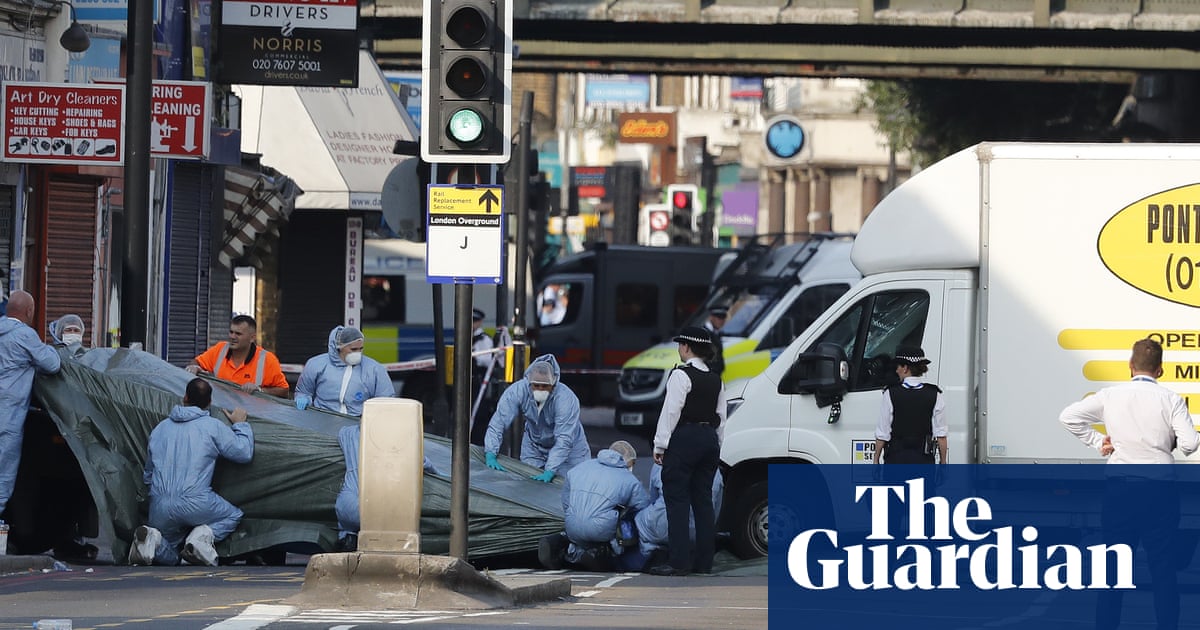
Show caption Forensic officers examine the van driven by Darren Osborne that killed Makram Ali outside Finsbury Park mosque in 2017. Photograph: Frank Augstein/AP Prevent strategy Terrorism in the UK: the rising threat of far-right extremists Since 2017, counter-terrorism forces have foiled 32 plots: 18 were Islamist related, and 12 were from the extreme right wing Vikram Dodd Police and crime correspondent Mon 16 May 2022 20.44 BST Share on Facebook
Share on Twitter
Share via Email
In MI5’s London headquarters there is a top secret grid, on which is ranked the top terrorist plots absorbing the attention and resources of the security services and police.
While 15 years ago it was dominated by Islamist plotters, in recent years the most severe threats to the country’s national security feature people planning atrocities linked to extreme rightwing ideology.
The official figures are sobering. They reveal that the United Kingdom faces twin threats of terrorist violence, from Islamists such as adherents of Islamic State, and from a far more disparate extremist far right, trying to trigger a race war to further their ideology.
Since March 2017, counter-terrorism police and the intelligence services have stopped 32 plots they assess as aiming to cause mass casualties on British soil. Of these they assess 18 were Islamist related, and 12 were triggered by extreme rightwing terrorist ideology. The other two were linked to category known as left, anarchist or single-issue terrorism (LASIT).
The last one to get through and kill was Darren Osborne, who drove a van into worshippers outside Finsbury Park mosque in north London in 2017, leaving one person dead. In his van was a note setting out his grievances. The investigation by police and MI5 discovered that he radicalised himself in a month, starting with mainstream material.
His note talked about grooming gangs, and police believe the catalyst for Osborne’s descent into hate was seeing a BBC drama about a sexual abuse scandal involving Muslim men, screened on a Sunday evening. That issue about grooming gangs was then used in online extremist propaganda against Islam. Osbourne read internet propaganda from Tommy Robinson, the founder of the English Defence League and material from Britain First, another extremist hate group.
The ratio of counter-terrorism investigations is still roughly six Islamist for every one from the extreme right wing, covering everything from plots to financing to propaganda. In March, assistant commissioner Matt Jukes, head of counter-terrorism, said that 19 out of 20 children who were arrested in the previous 12 months for terrorism offences were linked to an extreme rightwing ideology.
Those falling for rightwing hate and then breaking terrorism laws were younger than those falling for Islamist hate, with techniques including online content based on violent video games shaped to indoctrinate them.
Jukes said that 41% of counter-terrorism arrests in 2021 were of extreme rightwing suspects.
Although the death toll in the UK from the extreme right wing has numbered single victims so far, including the assassination of Jo Cox MP in 2016, mass murders in Christchurch and now Buffalo give the lie to any notion the ideology is any less effective at delivering carnage.
The government review of Prevent was hoped to refresh and save it. The national security imperative was to find a way of diverting recruits to terrorism, before it was too late.
William Shawcross’s appointment as chair of the review was greeted by a boycott from human rights group and Muslim organisations because of his past comments.
But his appointment was also feared by some in counter-terrorism over concerns his findings would be so extreme they would kill what credibility Prevent had left, if they were enacted.







